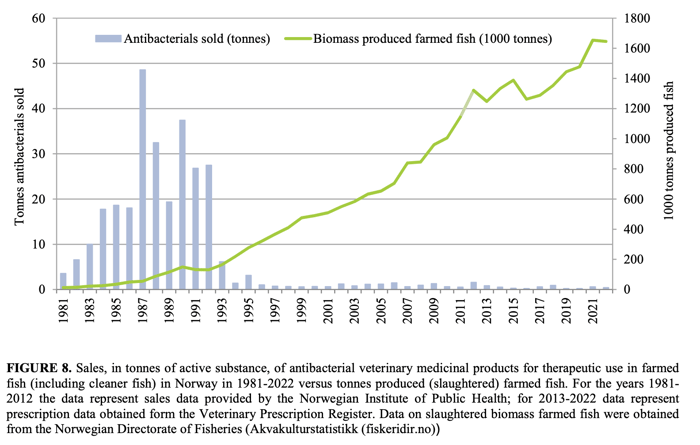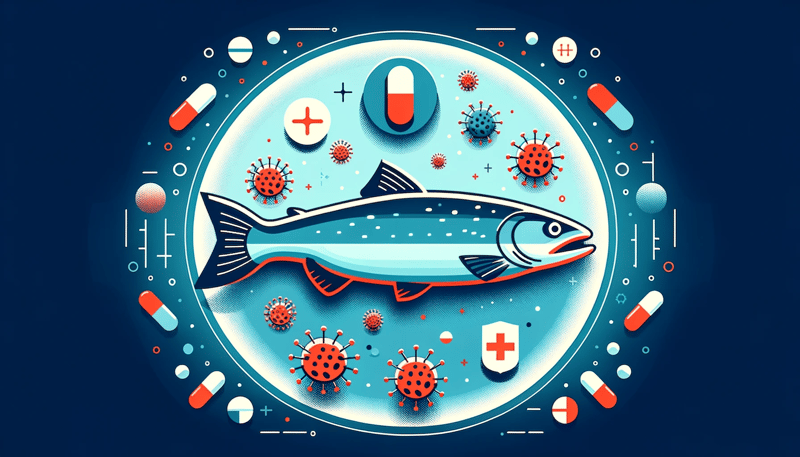Bacteriophages in Aquaculture: The Industry's Future Health Hero?
The well-being of animals and the prevention of diseases are the primary concerns for farmers, whether they work on land or at sea. While we have previously discussed the difficulties in creating therapeutics like vaccines, there is another fascinating technology that is gaining momentum: bacterial phages.
Let's delve into the intriguing history of bacteriophages, exploring their potential, the reasons we have yet to fully utilize them, and how the growing problem of antibiotic resistance is sparking a renewed fascination in these remarkable organisms.
To illustrate their practical application, we will focus on their use in the salmon industry, examining how commercial phage solutions are revolutionizing the fight against winter wounds. Lastly, we'll look at some of the challenges ahead for phage biotech companies and how one particular company in salmon, ACD Pharma, is at the forefront of unique research that may lead to the commercialization of phage therapy across aquaculture.
A Scientific Recap of Bacteriophages
Let's begin with a brief scientific overview of phages - what they are, where they can be found, and why they hold such significance. Phages, in simple terms, are viruses that specifically target bacteria. Discovered by the French-Canadian scientist Félix D'Herelle in 1920, they are nature's own defense mechanism against bacteria, designed to precisely locate and attack specific strains. Interestingly, phages make up an astounding 40% of all matter in the ocean, showcasing their omnipresence.
To locate these remarkable organisms, one must venture to the areas teeming with bacteria. Phage researchers often find themselves exploring sewage plants, contaminated waterways, and other unappealing locations in search of their target phages.
Given their potential, one might assume that phages would have been widely utilized to tackle various bacterial issues. However, the development of modern medicine took a different path.
Why Antibiotics Had a Historical Advantage
To understand why phages weren't widely utilized in the past, we need to consider the global circumstances of that time. After World War I, disease emerged as a hidden challenge of war. In the same decade, Alexander Flemming made the groundbreaking discovery of penicillin in 1928, which eventually led to the development of broad-spectrum antibiotics. Antibiotics have since become one of the greatest medical achievements of the 20th century, saving millions of lives and playing a crucial role in modern medicine.
Compared to phages, antibiotics had practical advantages as the world entered World War II. They were able to target a wide range of bacteria, making it unnecessary to identify the specific bacteria causing an infection. This meant that doctors could prescribe antibiotics without the need for extensive testing. On the other hand, using phages required identifying the specific bacteria infecting a person and finding the corresponding phage to target that bacteria.
As a result, significant research budgets were allocated to the development of antibiotics by governments and corporations. This shift in focus led to a decline in phage research in the Western world, as antibiotic research took precedence.
Changing Tides: The Rise of Antibiotic Resistance
As our use of antibiotics has increased over the years, so has the concern over antibiotic resistance. Bacteria have naturally evolved to become more resistant, leading to the implementation of stricter restrictions on antibiotic usage in both humans and farmed animals. This trend is also evident in the aquaculture industry, where antibiotics were historically used to combat various challenges. For example, Norwegian salmon has significantly reduced its antibiotic usage by over 99% since the peak in the mid-80s and has been practically antibiotic-free since the mid-90s.

Similar patterns can be observed in other salmon markets. Just recently, the Scottish salmon farming sector reported a 65% decrease in antibiotic usage for their fish since 2021. In comparison to other forms of animal husbandry, the salmon sector is performing exceptionally well, with approximately three times less antibiotic usage than pig farming, which stands at 18.6 mg per kg of meat produced.
However, despite the decrease in antibiotic usage, the threat of bacterial infections still exists. This is where bacteriophages have gained renewed attention in the past decade. The concept behind phages is highly logical - similar to penicillin and other antibiotics, phages are designed to target and kill specific bacteria. If we can identify the right phage that targets a specific bacteria, it is theoretically possible to mass-produce and deploy phages to eliminate harmful bacteria.
The Current Phage Therapy Status
So what’s the current status of phage therapy and its usage?
As interest in finding new solutions grows, so does the research and funding behind phages. While phage therapy has largely been overlooked in the western world, significant progress has been made in eastern European countries such as Poland, Georgia, and Russia. Scientists in these regions have been diligently cataloging phages and curating collections for therapeutic use.
Venture funding has also been directed towards phage solutions for farm animals, including Proteon Pharmaceuticals' $21 million round based in Poland. This company is focused on developing phage therapies for livestock and aquaculture and has garnered interest and support from industry leaders such as Nutreco and AquaSpark. Additionally, there are numerous funded companies targeting human phages.
However, when it comes to commercial progress in the aquaculture sector, one standout example is ACD Pharma in Norway. Over the past few years, they have been at the forefront of developing phages specifically for the salmon industry. Their commitment to research and development has positioned them ahead of many other companies in this field.

Saving Millions for Farmers? The Exciting Potential of Phage Therapy
The potential of phage therapy is undeniably exciting, and we're eagerly keeping track of the progress of these cases worldwide for several compelling reasons. Firstly, global leaders are in unanimous agreement about the urgent need to reduce the use of antibiotics, particularly in farm animals where a significant portion of their usage occurs. Phages offer a scientifically promising alternative to combat bacteria, making them a strong contender for addressing this pressing issue.
In recent years, there has been a focus on developing phage products to tackle winter wounds in the Norwegian salmon industry. These sores, or ulcers, are a result of bacterial infections from within the fish that can develop into problematic lesions and wounds. The Veterinary Institute in Norway documented in a recent report that the increasing cases of these sores have become the third leading cause of death at farms, with approximately 50% of all farms in Norway reporting cases across the country.
Not only does this bacterial disease cause mortalities, but fish that make it to harvest with wounds are priced significantly lower due to the grading of their poor fillets. In fact, publicly traded salmon company Lerøy reported a substantial drop of 18% in the price of salmon in 2022 due to issues with sores at their farms.
The winter wounds in the salmon industry account for over $750 million in losses across the industry. It is clear that everyone involved in the industry, from farmers to other stakeholders, is intensely interested in finding new solutions that would lead to better welfare and business outcomes.
Bacteriophages have become a hot topic of discussion and garnered significant attention in addressing the issue of bacterial infections. A leading player in this field is ACD Pharma, a Northern Norway-based company that was established in 2013 under the Nordly Holding group. They have been at the forefront of developing phages specifically for treating wounds in the salmon industry. Over nearly a decade, they have dedicated themselves to tailoring phages to meet the specific needs of the salmon industry, positioning themselves ahead of their competitors.
In the realm of modern medicine, the regulatory frameworks and intellectual property rights surrounding phage therapy are still in the complex and ever-evolving stages of development. Despite these challenges, companies like ACD have managed to piece together crucial elements and have successfully introduced commercially available phage products to the market. However, further research is imperative to fully comprehend the true effectiveness and long-term implications of phage therapy. Nevertheless, phages offer a scientifically promising alternative and have the potential to play a significant role in addressing this urgent issue.
Key Reasons to be Optimistic for the Future of Bacteriophages
There is immense potential for the future development of early solutions like bacteriophages. While they may not be perfect, there are exciting reasons to believe in their potential. Let me share two final key points with you.
1. Global Need to Reduce Antibiotic Usage
Firstly, global leaders unanimously agree on the urgent need to reduce the use of antibiotics worldwide, particularly in farm animals. As a matter of fact, 66% of all antibiotics used globally are consumed by farm animals, making them a major contributor to this problem. It is crucial to find alternative solutions to combat bacteria, and scientifically, phages are among the best candidates.
2. Bacteriophages Promise Across Species
Secondly, the development of phages for aquaculture holds great promise due to their broad range of impact across various species. We previously have highlighted the challenge of delivering medicines to fish, such as the need to inject them with vaccines on land. Bacteriophages provide an immediate solution to this problem, enabling the development of therapeutics for a multitude of challenges.
From tackling vibrio in oysters to addressing EMS in shrimp, phages have the potential to solve numerous billion-dollar problems in the aquaculture industry. These solutions will greatly benefit farms and provide essential tools for their operations.